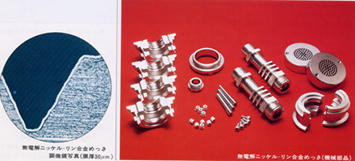Metals having excellent chemical resistance (corrosion resistance) include titanium and tantalum, where noble metals, amorphous nickel-phosphorus (with a high content of phosphorus), etc., are available as platable chemical-resistant plating. The chemical resistance of noble metal plating degrades with pinholes. On the other hand, the chemical resistance of nickel plating and chromium plating is improved by passivation of plating films.
| Type of plating | Characteristic value | Uses |
|---|---|---|
| Noble metal (gold, platinum, rhodium, palladium) plating, chromium plating, nickel plating | - 30μm or more required for nickel plating. - 100μm or more required for chromium plating. Being resistant to sulfuric acid environments. - Noble metal plating films are sensitive to strong acids including halogen ions. |
Chemical devices, electrode materials |
| Electroless nickel-phosphorus plating | - Plating film thickness 10 – 100μm. Being resistant to halogen-based environments. | Pipes, valves, heat exchangers, etc. |
| Tin plating | - Being resistant to organic acids. | Food-related instruments, such as the inner plating of cans |

Electroless nickel-phosphorus plating